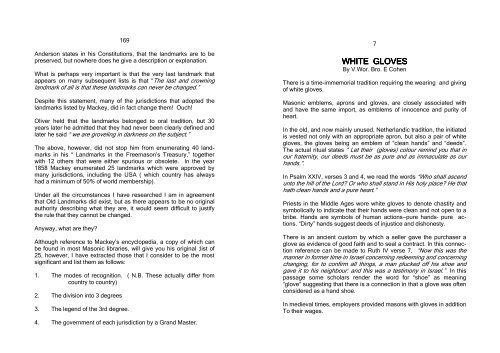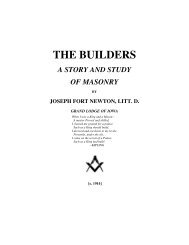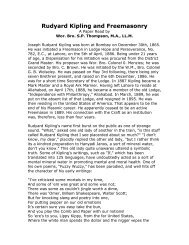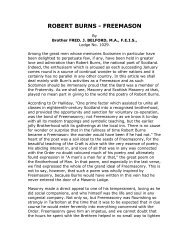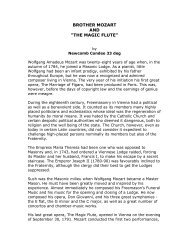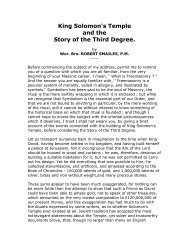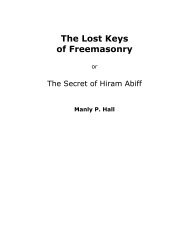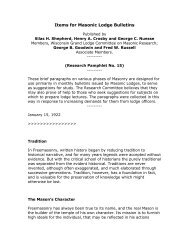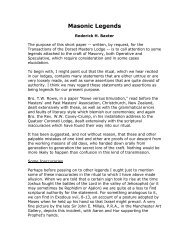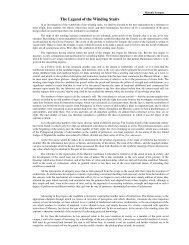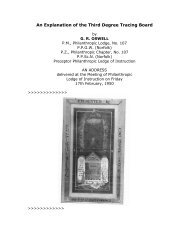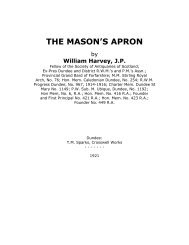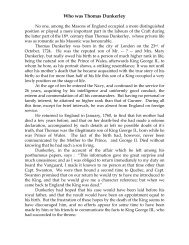Through the Key Hole - RoseCroix.org.au
Through the Key Hole - RoseCroix.org.au
Through the Key Hole - RoseCroix.org.au
Create successful ePaper yourself
Turn your PDF publications into a flip-book with our unique Google optimized e-Paper software.
169<br />
Anderson states in his Constitutions, that <strong>the</strong> landmarks are to be<br />
preserved, but nowhere does he give a description or explanation.<br />
What is perhaps very important is that <strong>the</strong> very last landmark that<br />
appears on many subsequent lists is that “The last and crowning<br />
landmark of all is that <strong>the</strong>se landmarks can never be changed.”<br />
Despite this statement, many of <strong>the</strong> jurisdictions that adopted <strong>the</strong><br />
landmarks listed by Mackey, did in fact change <strong>the</strong>m! Ouch!<br />
Oliver held that <strong>the</strong> landmarks belonged to oral tradition, but 30<br />
years later he admitted that <strong>the</strong>y had never been clearly defined and<br />
later he said “ we are groveling in darkness on <strong>the</strong> subject.”<br />
The above, however, did not stop him from enumerating 40 landmarks<br />
in his “ Landmarks in <strong>the</strong> Freemason’s Treasury,” toge<strong>the</strong>r<br />
with 12 o<strong>the</strong>rs that were ei<strong>the</strong>r spurious or obsolete. In <strong>the</strong> year<br />
1858 Mackey enumerated 25 landmarks which were approved by<br />
many jurisdictions, including <strong>the</strong> USA ( which country has always<br />
had a minimum of 50% of world membership).<br />
Under all <strong>the</strong> circumstances I have researched I am in agreement<br />
that Old Landmarks did exist, but as <strong>the</strong>re appears to be no original<br />
<strong>au</strong>thority describing what <strong>the</strong>y are, it would seem difficult to justify<br />
<strong>the</strong> rule that <strong>the</strong>y cannot be changed.<br />
Anyway, what are <strong>the</strong>y?<br />
Although reference to Mackey’s encyclopedia, a copy of which can<br />
be found in most Masonic libraries, will give you his original ;list of<br />
25, however, I have extracted those that I consider to be <strong>the</strong> most<br />
significant and list <strong>the</strong>m as follows:<br />
1. The modes of recognition. ( N.B. These actually differ from<br />
country to country)<br />
2. The division into 3 degrees<br />
3. The legend of <strong>the</strong> 3rd degree.<br />
7<br />
WHITE GLOVES<br />
By V.Wor. Bro. E Cohen<br />
There is a time-immemorial tradition requiring <strong>the</strong> wearing and giving<br />
of white gloves.<br />
Masonic emblems, aprons and gloves, are closely associated with<br />
and have <strong>the</strong> same import, as emblems of innocence and purity of<br />
heart.<br />
In <strong>the</strong> old, and now mainly unused, Ne<strong>the</strong>rlandic tradition, <strong>the</strong> initiated<br />
is vested not only with an appropriate apron, but also a pair of white<br />
gloves, <strong>the</strong> gloves being an emblem of “clean hands” and “deeds”.<br />
The actual ritual states “ Let <strong>the</strong>ir (gloves) colour remind you that in<br />
our fraternity, our deeds must be as pure and as immaculate as our<br />
hands.”.<br />
In Psalm XXIV, verses 3 and 4, we read <strong>the</strong> words “Who shall ascend<br />
unto <strong>the</strong> hill of <strong>the</strong> Lord? Or who shall stand in His holy place? He that<br />
hath clean hands and a pure heart.”<br />
Priests in <strong>the</strong> Middle Ages wore white gloves to denote chastity and<br />
symbolically to indicate that <strong>the</strong>ir hands were clean and not open to a<br />
bribe. Hands are symbols of human actions—pure hands– pure actions.<br />
“Dirty” hands suggest deeds of injustice and dishonesty.<br />
There is an ancient custom by which a seller gave <strong>the</strong> purchaser a<br />
glove as evidence of good faith and to seal a contract. In this connection<br />
reference can be made to Ruth IV verse 7, “Now this was <strong>the</strong><br />
manner in former time in Israel concerning redeeming and concerning<br />
changing, for to confirm all things, a man plucked off his shoe and<br />
gave it to his neighbour: and this was a testimony in Israel.” In this<br />
passage some scholars render <strong>the</strong> word for “shoe” as meaning<br />
“glove” suggesting that <strong>the</strong>re is a connection in that a glove was often<br />
considered as a hand shoe.<br />
In medieval times, employers provided masons with gloves in addition<br />
To <strong>the</strong>ir wages.<br />
4. The government of each jurisdiction by a Grand Master.


